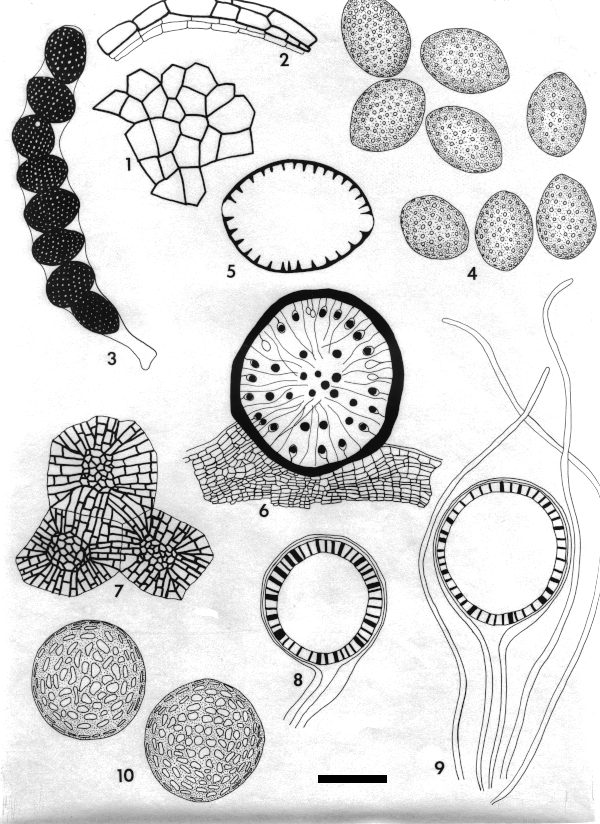Essays >> Cleistothecial Ascomycota >> Cleistothecial Ascomycota - Plate 01
Cleistothecial Ascomycota - Plate 01

1-5. Neurospora endodonta (Malloch & Cain) Dania García, Stchigel & Guarro
1. Surface of the peridium (X825). 2. Cross section of the peridium (825). 3. Ascus (X 633). 4. Ascospores (X 825). 5. Ascospore in optical section showing inwardly projecting spines.
6-10. Monosporascus monosporus (Malloch & Cain) D. Hawksw. & Ciccar.
6. Cross section of ascoma partially imbedded in a rhizome of Iris sp. (X 70) 7. Cephalothecoid peridial polygons (X 412). 8. Ascus (X 825). 9. Ascus and paraphyses (X 825). 10. Ascospores (X 825).
Neurospora endodonta was originally desribed by Malloch & Cain (1971) as a species of Anixiella, a genus used at the time for species of Neurospora (Sordariomycetidae) lacking an ostiole and having passive ascospore dispersal. It is grouped in the genus among a few species having relatively thin-walled ascospores with pits extending inwardly as conical spines. The illustration is from TRTC 45305, a culture isolated from Australian soil by Dr. Jack Warcup and sent to Dr. Cain for identification. The ascosores of N. endodonta appear to be strongly resistant to collapsing. When the ascospores are broken, the wall often everts and appears to be spiny, indicating a strong tendancy to avoid being crushed.
Neurospora endodonta is one of a number of species, including those on Plate 02 and perhaps numbering as many as 50, assigned at one time to the genus Gelasinospora. The genus was originally described in 1933 (Can. J. Res. 9: 294-305) by the pioneering Canadian mycologist Eleanor Silver Dowding. Dowding's original two species, G. tetraspora and G. cerealis, were joined by several more, including the ones on this and the next plate. Using morphological and molecular evidence, García et al. (Mycol. Res. 108: 1119-1142. 2004) argued that Gelasinospora should be considered to be a later and synonymous name of the genus Neurospora, described by the American mycologist C. L. Shear and B. O. Dodge and characterized by its ascospores having longitudinal ribs. García et al. discussed this combined group in detail and provided a dichotomous key to 49 species, including 11 species with ribbed and 38 species with pitted ascospores.
Monosporascus monosporus was also described originally as a species of Anixiella (Malloch & Cain, 1971). Although it has pitted ascospores, it is unlike other species of Neurospora in having monosporous asci and in growing on living plants. The illustrations were made from the holotype (TRTC 44885), described from a piece of Iris rhizome from Iran, intercepted by the USDA in New jersey and sent to Dr. Cain for identification. It was not grown in culture and only studied on the original substrate.
Hawksworth and Ciccarone (Mycopath. Mycol. appl. 66(3): 151. 1979.), calling attention to its growth on roots and one-spored asci, transferred A. monosporus to the genus Monascosporus. More recently Negreiros et al. (Ann. Appl. Biol. 174(3): 349-363. 2019) studied a number of similar fungi parasitic on roots in Brazil and, using molecular data, added an additional five species to the genus and assigned them to the family Diatrypaceae (Sordariomycetidae). According to the current MycoBank list, there are now nine species of Monascosporus. All are parasitic on roots, have asci with fewer than 8 ascospores and occur in semi-arid regions. The ascospores can be smooth, granular or reticulate. Unfortunately there were no cultures or sequences available to Negreiros et al. for M. monosporus, so they were unable to confirm its placement in Monascosporus Rechingeriella insignis Petrak, described from roots of Allium scabriscarpum in Iran, may be related.